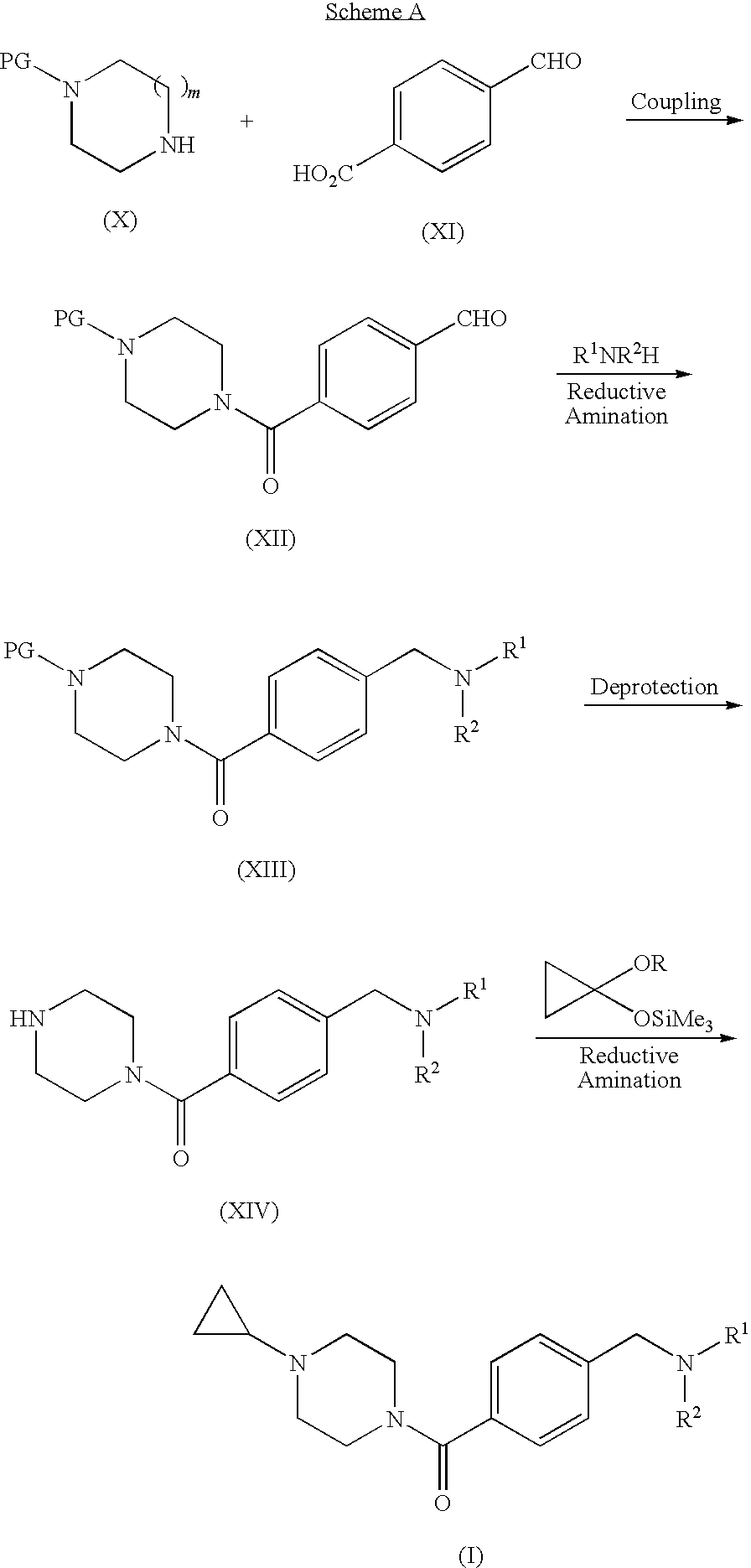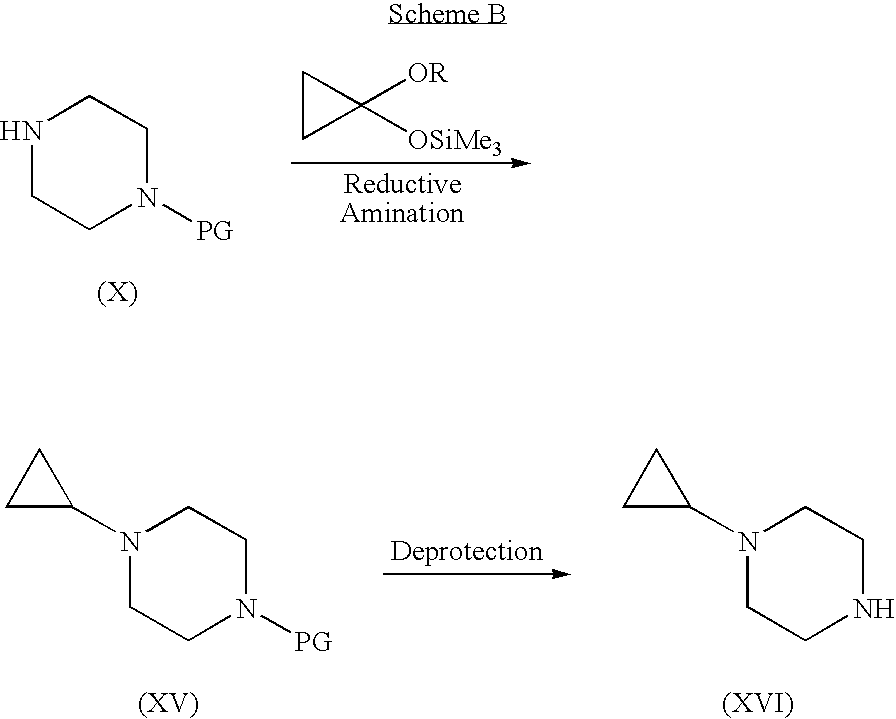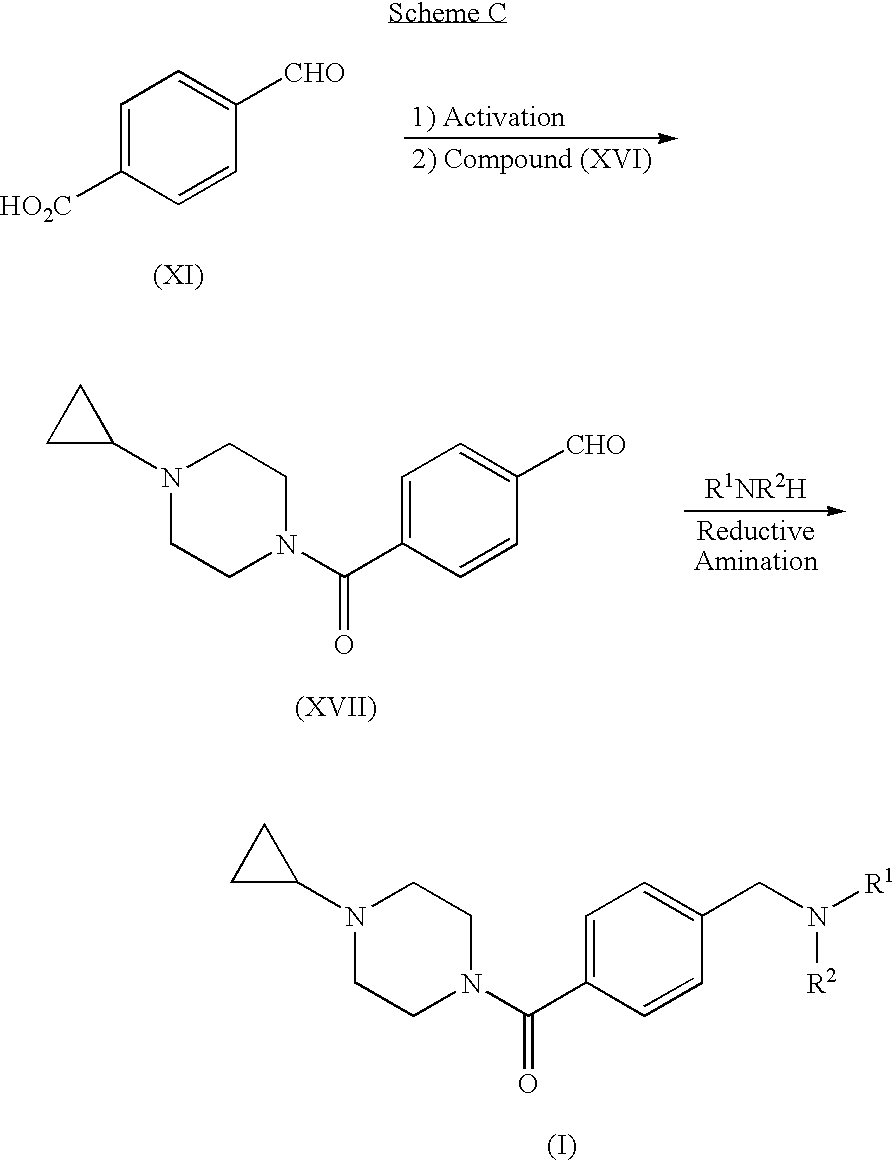Cyclopropyl Amines as Modulators of the Histamine H3 Receptor
a technology of cyclopropylamine and histamine h3, which is applied in the field of cyclopropylamines, can solve problems such as unsatisfactory side effects, and achieve the effects of improving permeability and volume of distribution, facilitating penetration of membranes, and improving permeability and permeability of membranes
- Summary
- Abstract
- Description
- Claims
- Application Information
AI Technical Summary
Benefits of technology
Problems solved by technology
Method used
Image
Examples
example 1
(4-Cyclopropyl-piperazin-1-yl)-(4-morpholin-4-ylmethyl-phenyl)-methanone
[0056]
[0057]Step A. 4-(4-Formyl-benzoyl)-piperazine-1-carboxylic acid tert-butyl ester. A suspension of 4-carboxybenzaldehyde (3.10 g) in CH2Cl2 was treated sequentially with piperazine-1-carboxylic acid tert-butyl ester (3.6 g), EDC (3.86 g), HOBt (2.68 g), and DMAP (˜0.020 g). After 18 h, the mixture was extracted with 1 N NaOH and then with 1 N HCl. The organic layer was dried (Na2SO4) and concentrated to give the title compound (5.11 g, 78%). MS (ESI): mass calcd. for C17H22N2O4, 318.16; m / z found, 219.3 [(M−100)+H]+. 1H NMR (CDCl3): 10.04 (s, 1H), 7.93 (d, J=8.2, 2H), 7.54 (d, J=8.1, 2H), 3.82-3.67 (m, 2H), 3.58-3.30 (m, 6H), 1.46 (s, 9H).
[0058]Step B. 4-(4-Morpholin-4-ylmethyl-benzoyl)-piperazine-1-carboxylic acid tert-butyl ester. A solution of 4-(4-formyl-benzoyl)-piperazine-1-carboxylic acid tert-butyl ester (2.06 g) in methanol (100 mL) was treated with morpholine (4 mL) and NaB(OAc)3H (6.98 g, in port...
example 1a
(4-Cyclopropyl-piperazin-1-yl)-(4-morpholin-4-ylmethyl-phenyl)-methanone dihydrochloride
[0066]A solution of (4-cyclopropyl-piperazin-1-yl)-(4-morpholin-4-ylmethyl-phenyl)-methanone (68.0 g) in ethanol (400 mL) was heated to 60° C. and treated with conc. HCl (37.8 mL) dropwise over 40 min. A precipitate started to form after ˜20 mL of HCl had been added. After the addition was complete, the thick suspension was slowly cooled to 20° C. over 3 h. The solid was collected by filtration, washed with ethanol, and dried at 50° C. overnight in a vacuum oven to provide the title compound as a white solid (56.2 g, 68%). HPLC: RT=4.30 min. MS (ESI): mass calcd. for C19H27N3O2, 329.21; m / z found, 330.0 [M+H+]. 1H NMR (400 MHz, D2O): 7.64 (pseudo d, J=8.3 Hz, 2H), 7.58 (pseudo d, J=8.3 Hz, 2H), 4.44 (br s, 2H), 4.20-3.10 (m, 16H), 2.88 (ddd, J=11.2, 6.6, 4.8 Hz, 1H), 1.03-0.98 (m, 4H). 13C NMR (101 MHz, D2O): 172.1, 135.3, 132.2, 130.9, 128.0, 64.0, 60.5, 52.6, 52.4, 51.7, 44.8, 39.7, 39.5, 3.9.
example 1b
(4-Cyclopropyl-piperazin-1-yl)-(4-morpholin-4-ylmethyl-phenyl)-methanone citrate salt
[0067]A mixture of (4-cyclopropyl-piperazin-1-yl)-(4-morpholin-4-ylmethyl-phenyl)-methanone (0.476 g, 1.45 mmol) and citric acid (0.281 g, 1.46 mmol) was diluted with methanol (˜10 mL). The mixture was heated until homogeneous and then concentrated. The resulting oil was triturated with ethyl acetate and the solid material that formed was dried under vacuum to yield the citrate salt (0.760 g).
[0068]The compounds in Examples 2-4 were prepared using methods analogous to those described in the preceding examples, with the appropriate substituent changes.
PUM
 Login to View More
Login to View More Abstract
Description
Claims
Application Information
 Login to View More
Login to View More - R&D
- Intellectual Property
- Life Sciences
- Materials
- Tech Scout
- Unparalleled Data Quality
- Higher Quality Content
- 60% Fewer Hallucinations
Browse by: Latest US Patents, China's latest patents, Technical Efficacy Thesaurus, Application Domain, Technology Topic, Popular Technical Reports.
© 2025 PatSnap. All rights reserved.Legal|Privacy policy|Modern Slavery Act Transparency Statement|Sitemap|About US| Contact US: help@patsnap.com



